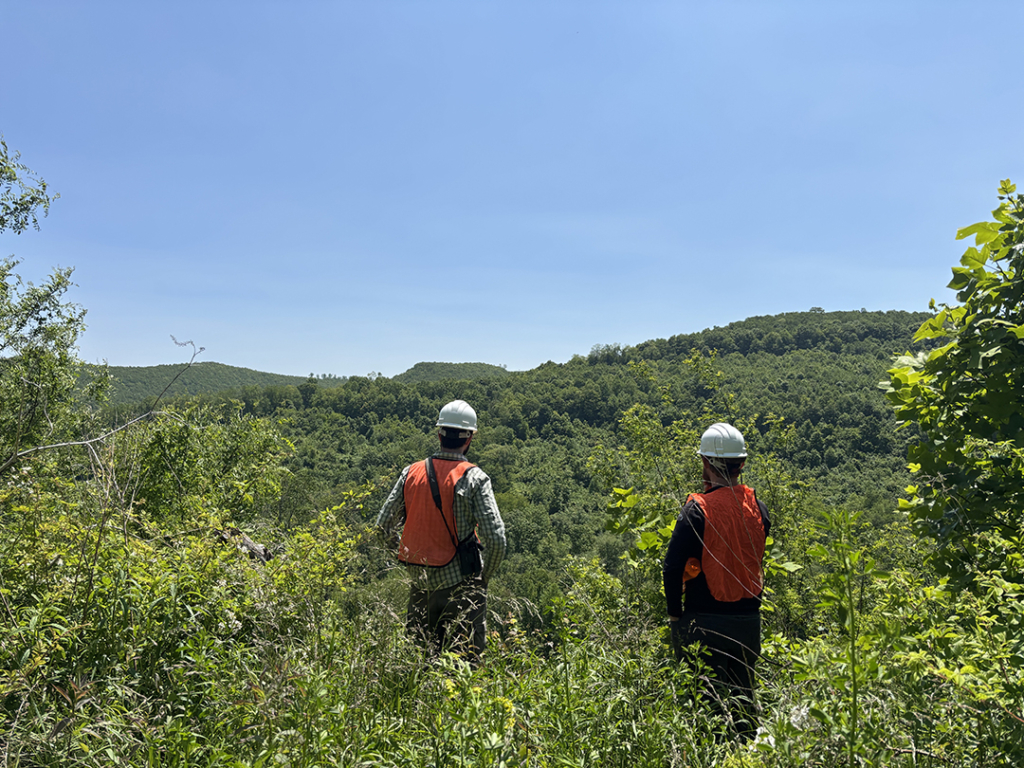By Lizzie Mafrici, Communications Coordinator at SFI
As the Sustainable Forestry Initiative (SFI) Communications Coordinator, I spend most of my time writing about the important work SFI is doing across our work in standards, conservation, community, and education to advance sustainability through forest-focused collaboration. I have become very passionate about connecting people to the natural world around them, even going so far as earning a master’s in applied entomology in 2023 to become a stronger science communicator.
 In my role, I work closely with Greg Cooper, Director of Conservation Implementation, and the rest of the conservation team to help create conservation knowledge products that provide insights, tools, and best practices to meet SFI standard requirements. Beyond science communications, Greg also works with the SFI network to address the conservation needs of certified organizations and advance focal topics like species biodiversity and climate smart forestry to continuously improve SFI’s approach to conservation work.
In my role, I work closely with Greg Cooper, Director of Conservation Implementation, and the rest of the conservation team to help create conservation knowledge products that provide insights, tools, and best practices to meet SFI standard requirements. Beyond science communications, Greg also works with the SFI network to address the conservation needs of certified organizations and advance focal topics like species biodiversity and climate smart forestry to continuously improve SFI’s approach to conservation work.
SFI advances conservation across forests in the United States and Canada through targeted research, the multi-year SFI Climate Smart Forestry Initiative, and partnerships that advance multiple conservation efforts. SFI contributes to long-term forest health and resiliency through expanded use of credible data, metrics, research, and reporting, and through partnerships that deliver data and tools to improve management practices. Our work spans climate adaptation and mitigation, fire resilience, water benefits, and species and ecosystem conservation. This extends to our SFI-certified organizations, who have directly invested $2.1 billion in forest research since 1995.
Recently, I had the opportunity to experience firsthand what that work looks like when I accompanied Greg and Julian Grudens, a Ph.D. student at West Virginia University and project lead, on a field day across SFI-certified Appalachian forestland. SFI was awarded a grant from the National Fish and Wildlife Foundation (NFWF) to engage West Virginia landowners in forest management that benefits bird species. Now in its second phase, SFI is collaborating with researchers and SFI-certified organizations to better understand how working forests across the Appalachian region can support species like the cerulean and golden-winged warblers. Partners in this effort include American Bird Conservancy, West Virginia University, NCASI, U.S. Department of Agriculture Natural Resources Conservation Service, West Virginia Department of Natural Resources, North Atlantic Forestry Organization, Weyerhaeuser, and The Lyme Timber Company.
During our visit, we focused on golden-winged warblers, migratory songbirds that live in deciduous young forest and shrubland, such as those created through sustainable timber harvesting. Julian and his research team have been collecting data on where golden-winged and cerulean warblers are present in relation to the age of timber harvests across the working forests.
 We started early, very early, to listen to the birds when they were most active, before the sticky summer heat kicked in. Julian, Greg, and I made our way across the landscape by truck and on foot, stopping at survey points to record the birds we heard or saw, along with details about the surrounding habitat and vegetation. Julian explained to us that his team of four has been conducting this work at sunrise from May through July to record the presence of golden-winged and cerulean warblers across the West Virginia landscape. By understanding where these birds live, this project aims to inform sustainable forest management practices and help us better understand how golden-winged and cerulean warblers interact with various habitats within working forests.
We started early, very early, to listen to the birds when they were most active, before the sticky summer heat kicked in. Julian, Greg, and I made our way across the landscape by truck and on foot, stopping at survey points to record the birds we heard or saw, along with details about the surrounding habitat and vegetation. Julian explained to us that his team of four has been conducting this work at sunrise from May through July to record the presence of golden-winged and cerulean warblers across the West Virginia landscape. By understanding where these birds live, this project aims to inform sustainable forest management practices and help us better understand how golden-winged and cerulean warblers interact with various habitats within working forests.
While trekking through the woods toward another survey point, Julian told us about how golden-winged warblers migrate roughly 3,200 miles/6,150 kilometers every winter, traveling all the way from the United States across the Gulf of Mexico and finally making it to wintering grounds in Latin and South America. Growing up close to the Appalachian region, I’ve always known that this area of the United States is considered a global biodiversity hotspot, but it didn’t fully click until I was standing under the tulip poplars listening to the sounds of the wide array of insects, birds, and animals that call this forest home.
SFI certified forests are expansive and diverse, and 98% of forests certified to the SFI Standard are even available for outdoor recreation. Across North America, there are multiple active research and monitoring projects taking place in these forests, and this work is critical to guiding sustainable forest management decisions. My trip to West Virginia brought to life the role these forests play in supporting healthy ecosystems and wildlife biodiversity. Hiking and driving through SFI-certified land provided me with an appreciation for how intentional and sustainable management shapes the landscape, creating a patchwork of habitats that support a wide variety of wildlife across the forest.
And yes, my early wake-up call was not in vain, Julian made sure we found a golden-winger warbler. Listening to its song helped me fully understand the importance of conservation work that supports biodiversity, and I pictured the massive journey these vibrantly colored birds made to end up above me in West Virginia’s forests.
A random Tuesday in June ended up being a meaningful day in my career as a science communicator. It brought to life many of the stories I talk about at SFI and helped me understand the diverse conservation projects SFI supports. In 2023 alone, SFI-certified organizations reported 560 different conservation, community, education, and research projects. Past work also includes examining the needs of a wide variety of birds on SFI-certified land. It also reminded me of the importance of getting out from behind my desk and into nature every once in a while.
I am grateful to the SFI partners that are committed to conservation efforts, whether that’s waking up at 4 am to track songbirds in West Virginia, or those studying the impact of wildfires on streams and fish in Oregon. SFI-certified forests are responsibly managed to provide habitat for multiple species, including species at risk.
Interested in sharing bird and tree habitat information? Explore how you can connect young people to this important work through Project Learning Tree and American Bird Conservancy’s Together for Birds collection, which builds forest literacy and inspires future conservationists.
